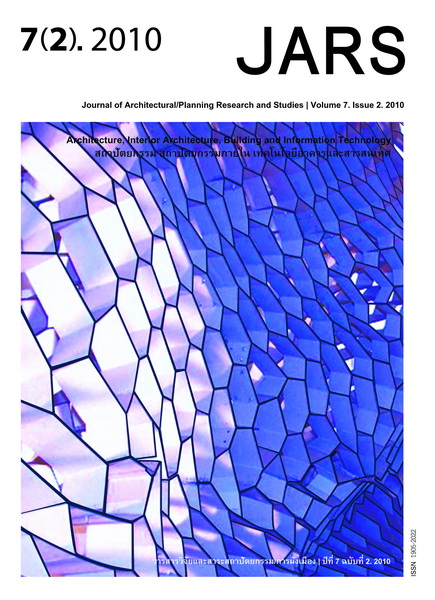Courtyard Compact House: Alternative Living Pattern for Urban Context in Tropical Regions
Main Article Content
Abstract
This article proposes the idea of the courtyard compact house, an alternative living pattern for urban
context in tropical regions. A plan configuration of courtyard compact house integrates between the contemporary
notion of compact house and the advantage of courtyard house from the past by applying an open
courtyard for creating an individual outdoor space into an efficient planning of compact house. The open
courtyard area not rather serves a variety of social activities in family life but also fits into tropical climate
owing to a natural ventilation design method. This design strategy might be an alternative for sufficient architecture
in limited area. The contents of this article include history and development of the courtyard house, the compact house, and the courtyard compact house configuration in Thailand and other South East Asian
countries. Furthermore, at the end of this article demonstrates the roles of this contemporary design vocabulary
reflecting the social and environmental dimensions which are important issues for the development of
tropical sustainable architecture in urban context.
Downloads
Article Details

This work is licensed under a Creative Commons Attribution-NonCommercial-NoDerivatives 4.0 International License.
All material is licensed under the terms of the Creative Commons Attribution 4.0 International (CC-BY-NC-ND 4.0) License, unless otherwise stated. As such, authors are free to share, copy, and redistribute the material in any medium or format. The authors must give appropriate credit, provide a link to the license, and indicate if changes were made. The authors may do so in any reasonable manner, but not in any way that suggests the licensor endorses you or your use. The authors may not use the material for commercial purposes. If the authors remix, transform, or build upon the material, they may not distribute the modified material, unless permission is obtained from JARS. Final, accepted versions of the paper may be posted on third party repositories, provided appropriate acknowledgement to the original source is clearly noted.
References
ASA Editors. (2008). ASA Awards 08: Architectural design awards showcase in 2008. Architectural Journal of the Association of Siamese Architects under Royal Patronage (ASA), (August-September).
Bahammam, O. (2006). The role of privacy in the design of the Saudi Arabian courtyard house. In B. Edwards, M. Sibley, M. Hakmi & P. Land (Eds.), Courtyard housing: Past, present and future. New York: Taylor & Francis.
Bahamon, A. (2002). Mini house. Singapore: Page One Publishing.
Bay, J. H., & Ong, B. L. (Eds.). (2006). Tropical sustainable architecture: Social and environmental dimensions. Oxford: Architectural Press.
Blaser, W. (1993). Mies van der Rohe: The art of structure. Basel, Switzerland: Birkhauser.
Blaser, W. (1995). Courtyard house in China (2nd ed.). Basel, Switzerland: Birkhauser.
Borasi, G. (Ed.). (2008). Some ideas on living in London and Tokyo by Stephen Taylor & Ryue Nishizawa. Montreal, Canada: Canadian Centre for Architecture.
Castillo, E. (2004). Minimalism: Design source. Singapore: Page One Publishing.
Charoensupkul, A. (1949). มีส ฟาน เดอร์ โรฮ์ และสถาปัตยกรรมตะวันออก [Mies van der Rohe and Eastern Architecture]. Phra Na Khon, Thailand: Krung Siam Printing.
Department of Architecture, Qinghua University. (1985). Historic Chinese architecture. Beijing: Qinghua University Press.
Ebrey, P. (n.d.). A visual sourcebook of Chinese civilization. Retrieved April 26, 2010, from http://depts.washington.edu/chinaciv/home/3intrhme.htm
Edwards, B., Sibley, M., Hakmi, M., & Land, P. (Eds.). (2006). Courtyard housing: Past, present and future. New York: Taylor & Francis.
Goad, P., & Pieris, A. (2005). New directions in tropical Asian architecture. Singapore: Periplus Editions.
Hart, K. (n.d.). Small is beautiful, in Greenhomebuilding.com. Retrieved April 26, 2010, from http://www.greenhomebuilding.com/articles/small.htm
Hawkes, D. (2006). The selective environment: Environment design and cultural identity. In J. H. Bay & B. L. Ong, Tropical sustainable architecture: Social and environmental dimensions. Oxford: Architectural Press.
Lauber, W. (2005). Tropical architecture: Sustainable and uumane building in Africa, Latin America and SouthEast Asia. New York: Prestel Publishing.
Lip, E. (1995). Feng Shui, environments of power: A study of Chinese architecture. London: Academy Editions.
McGillick, P. (2006). 25 Tropical houses in Singapore and Malaysia. Singapore: Periplus Editions.
Memarian, G., & Brown, F. (2006). The shared characteristics of Iranian and Arab courtyard house. In B. Edwards, M. Sibley, M. Hakmi & P. Land (Eds.), Courtyard housing: Past, present and future. New York: Taylor & Francis.
Ota, S. (2006). Tropical and traditional: Inventing a new housing model for the Old 36 Streets Quarter in Hanoi, Vietnam. In J. H. Bay & B. L. Ong, Tropical sustainable architecture: Social and environmental dimensions. Oxford: Architectural Press.
Phattanawasin, S. (2002). ทัศนคติต่อที่ว่าง: อัตลักษณ์ที่ซ่อนเร้นในสถาปัตยกรรมพื้นถิ่นเอเชียร่วมสมัย [Attitude toward space: Hidden identity in contemporary Asian vernacular architecture]. Journal of Architectural Research and Studies, 1, 129-153.
Powell, R. (1998). The urban Asian house: Living in tropical cities. Singapore: Select Books.
Powell, R. (2001). The new Asian house. Singapore: Select Books.
Satrabhandhu, O. (2010). ลานว่างระหว่างอาคาร [Courtyard]. A lecture note by the author in “2010 National Autists”, a recognition exhibition at Thailand Cultural Centre, organized by the Office of the National Cultre Commission, Ministry of Culture, Thailand.
Tashiro, H. (2007). Japan: Micro-homes in the big city, in Bloomberg Businessweek on March 13, 2007. Retrieved April 26, 2010, from http://www.businessweek.com/globalbiz/content/mar2007/gb20070313_145902.htm
Valle, C. D. (2005). Compact houses. Singapore: Page One Publishing.
Zako, R. (2006). The power of the veil: Gender inequality in the domestic setting of traditional courtyard houses. In B. Edwards, M. Sibley, M. Hakmi & P. Land (Eds.), Courtyard Housing: Past, present and future. New York: Taylor & Francis.


